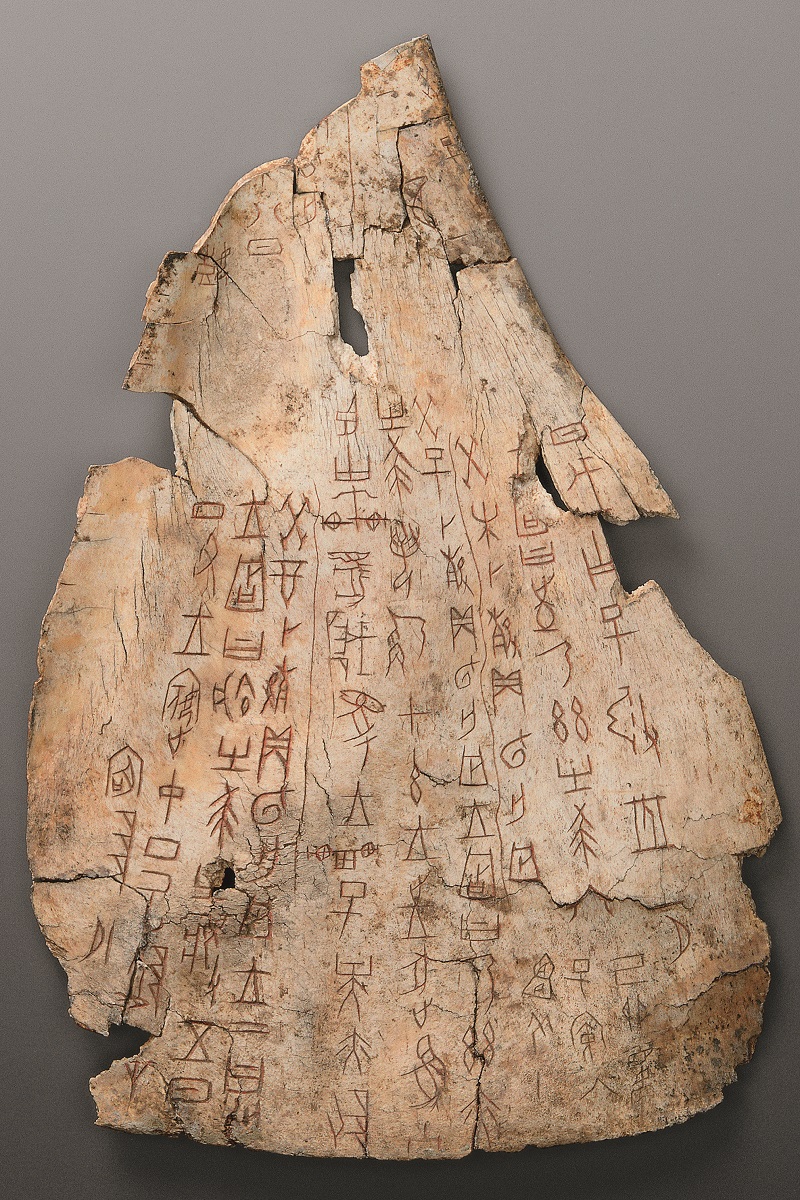China’s First Recorded Vehicular Crash

The Wangbinzhongding oracle bone is known for a total of 10 divination inscriptions on both sides. It was named after the characters “王宾中丁” (Wangbinzhongding) it contains, a phrase referring to a king introducing deceased kings, a procedure involved in sacrifice. As a big and complete oracle bone with only minimal damage, it is a rare cultural relic. The strokes of the characters were etched in red, further increasing its singularity and sacredness. This piece is a treasure of the Shang Dynasty (1600-1046 B.C.). The content of the inscriptions is mainly about divination of good and bad things across 10 days. These inscriptions cover a wide range of activities including sacrifice, hunting, weather and daily activities of the King of Shang. But perhaps the most fascinating feature of the oracle bone is record of a traffic accident.
The second half of the fourth divination on the front of the bone depicts a story: On Jiawu day, the King of Shang went to hunt rhinoceros. The axle of Official You’s chariot broke, causing the horses to fall. The king’s chariot was turned upside down in the process. Prince Zi Yang also fell from the chariot. At least two major things can be drawn from the tale: Methods of hunting in the Shang Dynasty are recorded with inscriptions on this oracle bone, and chariots from the period are described with Chinese hieroglyphic characters.
Hunting was among significant activities of a king in the late Shang Dynasty. The practice of hunting far transcended acquiring prey for food. It served as a chance for military training, practicing with weaponry and even patrolling the borders. The activity had important political and military implications. Inscriptions about hunting are an important part of oracle bones unearthed at the Yin Ruins, where over 5,000 related artifacts were found. According to those inscriptions, Shang aristocrats sought over 10 species of animals including tigers, rhinoceros, deer, elk, elephants, water deer, wild boars, swallows, and fish. Methods of hunting included netting, setting traps, shooting with arrows, burning fields, surrounding prey and even hand-to-hand combat. According to the section on the Yin Dynasty (an alternate name of the Shang Dynasty) in Records of the Grand Historian, an ancient masterpiece that covers Chinese history up to the early days of the Western Han Dynasty (202 B.C.-8 A.D.), King Zhou of Shang fought a beast hand-to-hand, which demonstrated his remarkable strength, skill and bravery. Moreover, through studying inscriptions on hunting, today’s people can determine considerable information about divinations, locations and tools used for hunting by Shang kings and aristocrats. The inscriptions also reveal sacrifice, military training and the Shang Dynasty’s relations with its dependencies. The inscriptions are also conducive to study of climate and phenology. The inscriptions on the Wangbinzhongding oracle bone record a Shang king’s hunt for a kind of rhinoceros. He was accompanied by You, a high-ranking official in charge of sacrifice, hunting and military, and Prince Zi Yang. They chased the rhinoceros by driving horse-drawn chariots.
Renowned archaeologist Xia Nai once pointed out that “usage of chariots is another characteristic of the Shang civilization.” By the late Shang Dynasty, chariots had become a popular choice for travel by aristocrats. In terms of structure, chariots of the era had already matured towards a standardized design. When aristocrats of the Shang Dynasty went hunting, they often used chariots. Comprised of two wheels, a shaft, an axle, and a carriage, this kind of vehicle was usually pulled by two horses. The Chinese character for “chariot” on oracle bones is a pictogram, the shape of which matched an unearthed chariot precisely. The Wangbinzhongding oracle bone has two characters related to the chariot which can be regarded as variants, but they stand for complicated things that require several words or even sentences to describe today. The first one resembles a chariot with a broken axle. The second, , has no shaft, but only the “田” shaped carriage, demonstrating that the carriage was under the axle, which clearly means that the chariot was upside down. These two variants of the pictogram “chariot” explain the whole event clearly and also provide details on the broken and overturned chariots. This exceptional piece serves as a pristine example of how flexibly oracle bone inscriptions could be used. In this version of oracle bone inscriptions, the character “人” (meaning “human”) had already evolved into clear lines, which evidences that Chinese characters were already transforming from pictograms to symbols in ancient times.
The author is an associate research fellow with the National Museum of China focusing on pre-Zhou Dynasty (1046-256 B.C.) archeology and pre-Qin Chinese history.